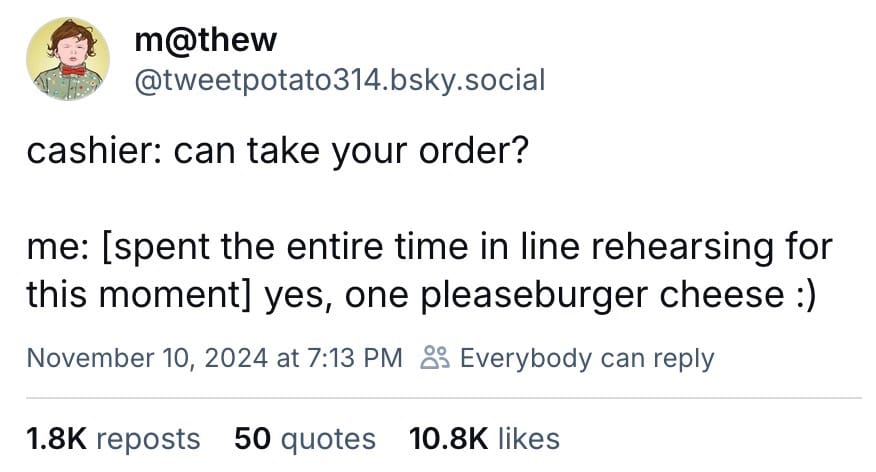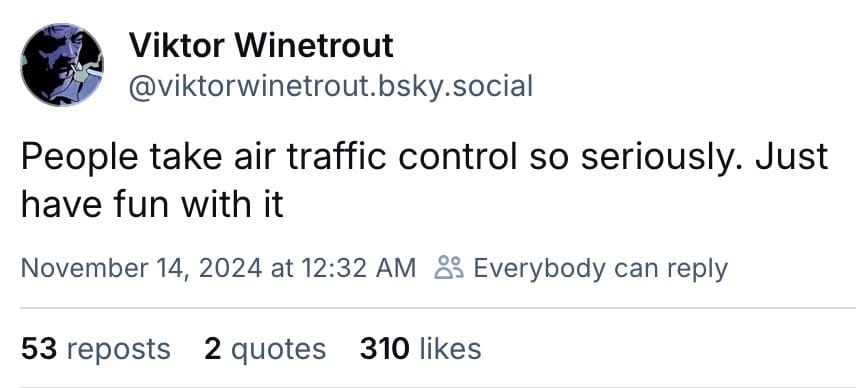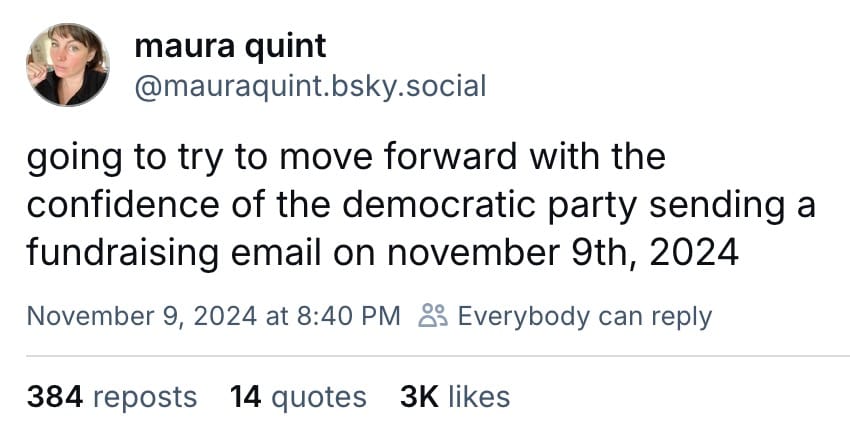Updates from Adam Isacson (November 16, 2024)
Hello, I’m back. My production of these “weekly” emails fell off when my two-month work sabbatical began six months ago. I failed to restart them because my election-season rapid-response communications work on the border and migration, especially the production of daily border updates, took far more of my time than I’d expected.
(Near the end of this message is a frank evaluation of how that “daily update” product went. They’re done for now, which frees up some time to restart these emails.)
The “rapid response” posture increased media response and citations, increased engagement with Congress, including another invitation to testify in a hearing, and boosted web traffic. That’s all great, but it absolutely did not stop the national border and migration narrative from shifting sharply in a rightward and human rights-dismissive direction.
I’m still reflecting on what we, and the small number of partner groups doing “narrative work” on minuscule budgets, could have done differently during the election season. Perhaps nothing: as we hurled truths and facts into the debate, maybe we were standing on a beach trying to hold back the tide.
I don’t have the answers yet. The communications lessons we draw from the past several months are crucial for how we operate after January 20. I welcome constructive insights about doing this work in the new climate.
One, I hope, is to “keep it up and make sure that credible information is available, free, widely distributed, and easy to understand.” That’s why I expect to resume publishing these emails on a regular weekly schedule.
My goal is to start publishing these at the end of each week (instead of Sunday-Tuesday as before) after we post the WOLA Weekly Border Update and I have a sense of the following week’s events. Hopefully, if your job gives you the weekend off, you can incorporate these into your weekend reading.
These messages will always be paywall-free, as long as I have a “day job” that allows me to do this work during business hours. So if you find these messages useful, in lieu of paying for a subscription, I encourage you to contribute to my organization, the Washington Office on Latin America, which is doing this work con las uñas, on a shoestring budget.
This week’s email has a lot: the weekly Border Update; a set of resolutions for post-election daily life; a WOLA podcast episode about what awaits us; an overview of border and migration trends through the end of the U.S. government’s 2024 fiscal year; next week’s relevant events that I know of; five interesting readings from last week; and a self-evaluation of a year of “daily border links” posts. Thank you for reading.
Weekly U.S.-Mexico Border Update: Trump’s appointees, expected migration increase, Darién Gap, Senate appropriations
- Read the whole thing here. See past weekly updates here.
- Read the final week of daily border links posts here. I've wound down this rapid-response effort; near the end of this e-mail, see a reflection about how that went.
THIS WEEK IN BRIEF:
In the days following his election to the presidency, Donald Trump has named three officials with direct border and migration responsibilities. All of them represent the Republican Party’s hard line on border security crackdowns and restriction of immigration. Stephen Miller will be Deputy Chief of Staff for Policy at the White House. Tom Homan will be in the White House as a “border czar.” Kristi Noem is the nominee to head the Department of Homeland Security. They will manage a planned “mass deportation” campaign while seeking to do away with legal migration pathways that the Biden administration preserved or established. Secretary of State-designate Marco Rubio will lead a foreign policy toward the Western Hemisphere, especially Mexico, for which migration will be a dominant issue.
Analysts and border-security planners continue to expect the number of migrants approaching the U.S.-Mexico border to increase ahead of Inauguration Day as people race to reach U.S. soil before a crackdown. So far, though, this has not materialized: Border Patrol apprehensions have actually dropped since Election Day.
22,914 people migrated in October through the treacherous Darién Gap region straddling Colombia and Panama. That is a modest drop from 25,111 in September, which may be due at least in part to weather conditions. The number of migrants from Venezuela (19,522) barely dropped from September.
The U.S. Senate Appropriations Committee, chaired by Democrats until the chamber switches to Republican control, published the text of its version of the 2025 appropriations bill for the Department of Homeland Security. It includes more money for CBP, especially for ports of entry, and more funding for shelters and local jurisdictions receiving and integrating released migrants. It does not include additional money to hire Border Patrol agents or to build new border barriers. It is unclear whether this bill will move forward. Republicans may seek to write their own bill after they assume the Senate majority in January, though that would require keeping the U.S. government open after December 20, the deadline for passing a 2025 budget.
Support ad-free, paywall-free Weekly Border Updates. Your donation to WOLA is crucial to sustain this effort. Please contribute now and support our work.
Bracing Yourself
(Posted Wednesday, November 6)
Here’s some unsolicited advice for how to go about daily life between now and January 20. You may have drawn up a list of your own today. If not, you may feel better after taking a moment to do so.
I’m absolutely not doing all of these things, though I’d like to start many of them.
- Resist the urge to post “outrage” takes on social media. Daniel Hunter calls that “public angsting,” adding, “It’s demoralizing us. It’s hurting our capacity for action.” Maybe read more instead. Or better yet, spend the time writing or creating something more thoughtful, something that adds value and context, requiring more “emotional labor” than a hot take. At the very least, say, a blog post at a space you own. Then, when that’s done, go to social media and link to it.
- Get off of Elon Musk’s Twitter. And look at Meta’s properties with skepticism, too. The ideal would be Mastodon—decentralized and immune from corporate takeovers, you can even own your own virtual managed server for not too much money, which I do. But very few people are there. More are on BlueSky, which is also run by a corporation that could change its behavior anytime, but at least for now it feels like “old Twitter.” The fact is, if you do communications, you still need a Twitter and Meta presence because so many audiences are still there: even though those audiences probably hate it, “network lock-in” is real. I’m limiting my own Twitter presence to posting links to items hosted elsewhere, and the very occasional quote-tweet. No original content.
- Read a lot. Read about the civil-rights era struggles that led to the social gains that this administration threatens to dismantle. Read about anti-authoritarian struggles worldwide. Read about what has worked. Read guides from people who have advised social movements, from Gene Sharp and Saul Alinsky to Srdja Popovic and adrienne maree brown, among many others. See also science fiction, from Octavia Butler to Cory Doctorow and many, many others.
- Learn best practices for interacting with aggressive security personnel. Know your rights regarding what you are and are absolutely not required to say and what you are not required to allow to be searched. Also, learn best practices for dealing with violent people and people who threaten others. Learn at least some basics of de-escalation and self-defense.
- Make more time for neighbors and co-workers as well as for family and friends. When you do, listen more than you talk.
- Turn up your computer’s security settings, even if they’re less convenient. Ditch spying browsers like Chrome. Change passwords. Use a password manager if you don’t already. Cancel accounts for digital services you don’t use. Delete little-used apps that may be leaking location and other data. Consider using a VPN. Encrypt all of your drives and devices. Add more digits to the PIN you use to unlock your phone. Look at more secure communications services like Signal and ProtonMail. Read more tips from the EFF. If your security needs are extreme, use a locked-down Linux distribution like Debian with privacy enhancements, Fedora with security modules, or even Qubes OS.
- Be gentler on yourself. Sleep 8 hours. Get exercise, but don’t overtrain; in fact, don’t even “train,” just take it slow, but get outside and see the sky. Cut back on—but don’t necessarily cut out completely—items that dull your alertness or weaken your body’s ability to deal with stress, such as booze, caffeine, drugs, refined sugars and carbohydrates, processed foods, and animal products.
- Be kind. Even to people who don’t seem to deserve it. Just err on the side of kindness. Lots of folks aren’t doing well right now.
WOLA Podcast: What Trump’s Return Means for Latin America

I recorded this late Friday with WOLA’s president, Carolina Jiménez, and our vice president for programs, Maureen Meyer. We walk through some of what that awaits us in Latin America during the second Trump administration: democratic backsliding, closing civic space, brutal crackdowns on migrants, old-school war on drugs, a collision course with Mexico.
We don’t have the blueprint yet for opposing the “authoritarian playbook” in the Americas. But if there’s a central message to this first-days conversation, it’s that the path back to democracy runs through a robust, creative, inclusive civil society. WOLA has been defending civil society partners throughout the region since 1974, and we’re going to continue doing that—now, here at home, too—during the coming storm that is no longer coming, it’s here.
Here’s the text of the podcast landing page at WOLA’s website:
We recorded this episode three days after Donald Trump won the 2024 presidential election. It brings together WOLA’s president, Carolina Jiménez Sandoval, Vice President for Programs Maureen Meyer, and Director for Defense Oversight Adam Isacson. Together, they possess a combined seven decades of experience working on human rights, democracy, and U.S. policy toward Latin America. All worked on these issues, plus borders and migration, through the first Trump administration.
Maureen, Carolina, and Adam discuss what Trump’s win means for democratic backsliding and relationships with authoritarian governments region-wide, as well as for migration policy, drug policy, cooperation with Mexico, and U.S. foreign aid and security programs.
Both Maureen and Carolina emphasize the importance of journalists, human rights defenders, advocacy groups, and other elements of civil society. Their role in protecting checks and balances and promoting accountability has never been more crucial. The civic space that they need to do their work is at great risk of closure amid attacks on independent media, disinformation, and threats of retribution emanating from the president-elect and his allies.
They note that a Trump presidency will probably reverse the U.S. government’s uneven but improving record as a force helping to shore up democratic rule, which has been eroding in the region and worldwide. Guatemala—where the presence or absence of U.S. support has been crucial for fair elections and anti-corruption efforts—is a key example. The incoming administration’s transactional, ideological stance risks withdrawing support for democratic rule, empowering autocrats with severe consequences for basic rights.
While the Biden administration curtailed access to asylum and did little to improve accountability for U.S. border forces’ human rights abuses, Maureen, Carolina, and Adam warn that Trump’s plans for the border and immigration could indelibly stain the United States. The president-elect’s proposed policies—closing migration pathways, “mass deportation,” militarization of border security—threaten to cause mass suffering and greatly complicate U.S. relations with Mexico and other regional governments.
Humanitarian organizations on the border, migrant shelters, and legal service providers, they point out, are especially in need of solidarity as they are now at risk of being targeted on a federal level, as Texas’s government has sought to do at the state level.
Carolina recalls that “WOLA has survived for over 50 years because we are part of an ecosystem that is under threat but resilient… It’s time to stick together and support each other and to do our work with more commitment and more energy than ever.”
Adam adds, “Times like these are the reason we exist… Stay with us.”
Thank you for listening, and take care of yourself and your community.
Download this podcast episode’s .mp3 file here. Listen to WOLA’s Latin America Today podcast on Apple Podcasts, Spotify, iHeartRadio, or wherever you subscribe to podcasts. The main feed is here.
Five Migration and Security Trends at the U.S.-Mexico Border
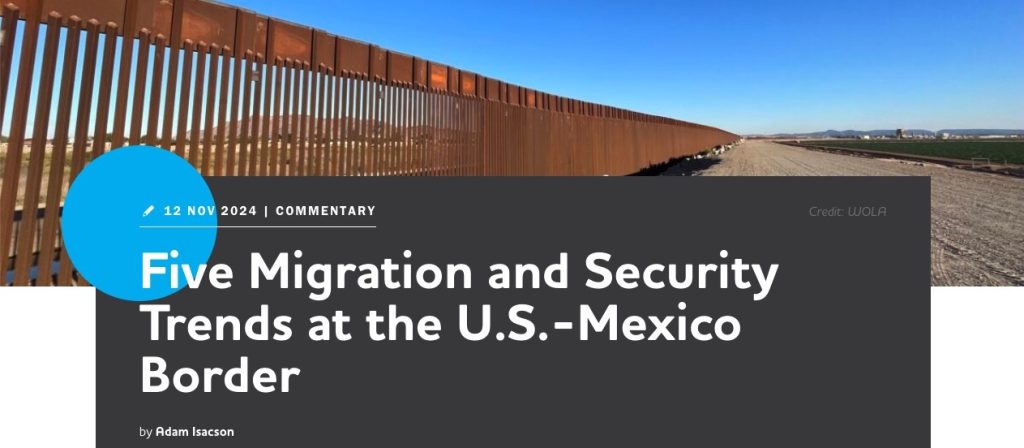
Here’s 2,000 words and 12 charts that I wrote and drafted before the Election Day cataclysm. In late October, the U.S. government published final fiscal year 2024 data about border and migration topics. I waded through all that and distilled it into five key trends:
- Crackdowns temporarily lowered numbers.

- Children and families made up 43 percent of migrants encountered.

- The geography of migration has undergone rapid post-pandemic shifts and moved west since the end of Title 42. Texas’s crackdown did not cause this.

- Migrant deaths may have declined. But deaths as a share of the migrant population have not.

- Fentanyl seizures dropped for the first time. It’s not clear why.

Read the whole thing, with text explaining these graphics, at WOLA’s website.
Darién Gap Migration Through October 2024
(Posted Wednesday, November 13)
Panama’s government posted updated data about the number of migrants encountered migrating through the Darién Gap jungles. While the number of people making the dangerous journey declined a bit (to 22,914 in October 2024, from 25,111 in September), the number of citizens of Venezuela barely budged (from 19,800 in September to 19,522 in October).
In fact, citizens of Venezuela (blue in the chart) made up 85 percent of all people who migrated through the Darién Gap in October. That’s Venezuela’s largest-ever monthly share of the Darién migrant population (it was 80% in September 2022).

Migration through the Darién Gap has declined from 2023, when Panama counted 520,085 people all year. 2024 is in second place, though, with 286,210 migrants during the year’s first 10 months.
Since 2022, an incredible 676,981 citizens of Venezuela have migrated through the Darién Gap. If there are about 30-32 million Venezuelan people, that is 1 out of every 47 of them.

The Helpers Need Help
If the fascism playbook calls for scapegoating a vulnerable minority, it also means heaping scorn and derision—or worse—on people who serve and defend that vulnerable minority.
I’ve had lots of conversations this week, both one on one and in coalition, with people assisting the migrant population that Donald Trump calls “animals” who are “poisoning the blood of our country.” I’ll have more conversations today.
They’re not doing well, and they’re preparing for retrenchment.
Shelter operators, pro bono attorneys, and rights defenders, at the U.S.-Mexico border and elsewhere, are bracing for the scale of suffering they’re about to see, and desolate about their limited power to do anything about it.
They’re also worried about themselves: Will they be able to operate? Will they be fending off legal challenges? Will their communications and relationships be subject to surveillance? Is their personal safety at stake, threatened by both aggressive security personnel and self-styled vigilantes?
They also feel alone and undefended. And that’s with good reason.
Will anyone in the political establishment defend them? An important sector of the Democratic Party absolutely will defend them, and defend the rights of immigrants in general. But will a majority of the Democratic Party step up? The Party that just spent an election season triangulating itself away from the migrant rights’ defense community and tacking rightward (with absolutely nothing to show for it)?
Will traditional legacy media step up, after hedging their endorsements and issuing incessant “Trump Pursues Ambitious Immigration Agenda” headlines?
It’s really not clear.
Helpers don’t deserve to be made to feel like this. If you know someone who does this work, please send them a message today and let them know you appreciate them and that you’ll stick up for them. They need it now, and they’re really going to need it soon.
Latin America-Related Events in Washington and Online This Week
(Posted Friday, November 15. These are events that I know of, anyway. All times are U.S. Eastern.)
Monday, November 11
- 9:00-2:30 at Georgetown University: Caring for the Other: Refugees and Displaced Persons (RSVP required).
- 9:00-6:00 at the Inter-American Human Rights Commission and online: Public Hearings of the Inter-American Commission on Human Rights (RSVP required).
Tuesday, November 12
- 9:00-6:00 at the Inter-American Human Rights Commission and online: Public Hearings of the Inter-American Commission on Human Rights (RSVP required).
- 11:00-12:30 at WOLA and online: ¿Por qué la comunidad internacional no puede ignorar la crisis en Perú? (RSVP required).
- 2:00 at atlanticcouncil.org: Assessing the halfway point of Colombia’s 2016 peace accord implementation (RSVP required).
Wednesday, November 13
- 9:00-6:00 at the Inter-American Human Rights Commission and online: Public Hearings of the Inter-American Commission on Human Rights (RSVP required).
- 10:00-11:00 at csis.org: Can Latin America’s Copper Be the Key to a Low-Carbon Future? (RSVP required).
- 10:00-11:30 at georgetown.edu: Caring for the Other: Refugees and Displaced Persons Webinar (RSVP required).
- 11:00-12:00 at wilsoncenter.org: The Drying Out of Central America (RSVP required).
Thursday, November 14
- 9:00-5:30 at the Inter-American Human Rights Commission and online: Public Hearings of the Inter-American Commission on Human Rights (RSVP required).
- 10:00-11:15 at wilsoncenter.org: Claudia Sheinbaum’s Security Strategy: A Path Forward? (RSVP required).
- 12:00-1:30 at refugeesinternational.org: U.S. Election Implications on Migration Policy in the Americas (RSVP required).
- 12:00 at Zoom: The Darien Gap: A Deadly Journey in the Pursuit of Safety (RSVP required).
- 1:00-2:00 at CGRS Zoom: Asylum and Climate Change: Identifying and Analyzing Climate-Related Claims in the United States (RSVP required).
- 2:00-3:30 at csis.org: Consult and Cooperate in Times of Great Need: Indigenous Rights and the Just Transition (RSVP required).
Friday, November 15
- 9:00-10:15 at wilsoncenter.org: USMCA After the Election: Key Challenges and the Path Forward (RSVP required).
- 9:00-5:30 at the Inter-American Human Rights Commission and online: Public Hearings of the Inter-American Commission on Human Rights (RSVP required).
Links From the Past Week
- This Is the Cake We Baked (This American Life, Sunday, November 10, 2024).
Transcript of an interview with top Biden-era ICE official Jason Houser, with striking insights into how far a Trump "mass deportation" campaign could go, even in its first months.
- On the Iron River: Guns Across the Border (London Review of Books, Thursday, November 21, 2024).
A review of Exit Wounds by Ieva Jusionyte and Soldiers and Kings by Jason de León. The first covers gun trafficking from the United States and the second covers migrant smuggling to the United States, but the two are interconnected.
- Roman Gressier, “For Trump, Central America Does Not Exist and Is Reduced to Migration” (El Faro (El Salvador), Monday, November 11, 2024).
Examines the potential impacts of Donald Trump’s return for Central America, highlighting fears of increased authoritarianism, transactional foreign policy, and reduced support for civil society and democracy.
- Emily Bregel, Analyzing Trump's Threats to Send Troops to 'Eliminate' Mexico's Cartels (The Arizona Daily Star, Monday, November 11, 2024).
Donald Trump’s approach to addressing organized crime in Mexico, including threats of military action and designation of cartels as terrorist organizations, risks undermining collaboration with the Mexican government and escalating violence without addressing its true causes.
- El Rastro Criminal de las Convivir en la Expansion Paramilitar en Uraba y Cordoba (El Espectador (Colombia), Sunday, November 10, 2024).
Summarizes a report from Colombia's transitional justice tribunal about the 1990s creation of armed citizen militias, which quickly combined with paramilitary groups and carried out vicious massacres while fully aligned with the armed forces, landowners, and other putatively "legal" actors.
How That Year of “Daily Border Links” Posts Went
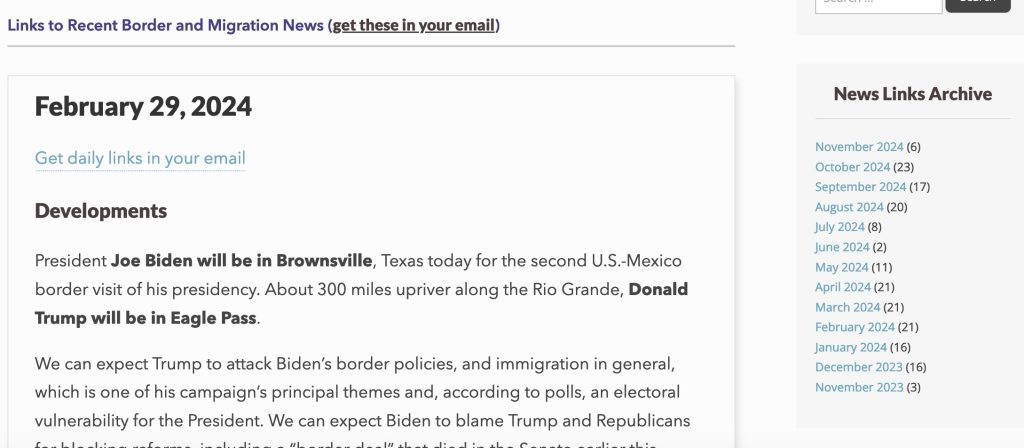
On November 27, 2023, with a U.S. presidential election nearly a year away, WOLA’s border and migration program embarked on a “rapid response” strategy to add facts and context to the narrative about one of the upcoming campaign’s main issues.
That day, we published the first of what would be 185 “Daily Border Links” posts totaling over 150,000 words (plus the link citations).
- Each one was a summary of that day’s U.S.-Mexico border-related news: breaking developments and deeper analysis pieces, with fully cited links below each item.
- Each was just a few hundred words: a quick read, most of the time produced by about 9:00 or 10:00 Eastern each weekday.
- I would then share them on WOLA’s Border Oversight microsite, on my own blog, and—as up to four attached images of each page’s text—on seven social media sites (Twitter, BlueSky, Mastodon, Threads, LinkedIn, Instagram, and Tumblr).
- I would also share them with three mailing lists: two NGO coalition listservs, and a Google Group open to the public. (You can still sign up for that and get WOLA’s Weekly Border Updates, which we’ve been producing since 2020.)
This was a key part of our “rapid response” strategy because it forced me to do the reading and to be excruciatingly up to date on every development and data point. It was an excellent tool for reaching journalists and fellow activists, experts, and service providers. It helped shape some news coverage, and I know that many people in government were reading it.
The idea was to run the Daily Border Links for a year, through U.S. Election Day, and then shut them down and move on. I would entertain the idea of continuing them if the level of demand and engagement was spectacular.
In the end, the level of demand for the “links” posts was healthy enough to have made it more than a worthwhile effort. But it was not overwhelming enough to merit continuing it beyond the election campaign year.
Here’s an evaluation of the experience:
The good
- As a rapid response strategy, the Daily Border Links succeeded in reaching journalists and NGO partners. It appeared to reach U.S. executive branch officials quietly: they knew about it but rarely interacted with them. Legislative staff give much more frequent feedback on our weekly updates, which are actual narratives, rather than on annotated links like the dailies.
- Having to write these each weekday kept me super sharp, which made my “post-9:00 AM” border and migration advocacy work far more effective. I know so much about what’s happening, in alarming detail. It made me a good interview, I think.
- I didn’t miss a single deeply reported piece, investigation, or NGO or government report. (Though I also see most of those when doing the weekly updates.)
- I’m very proud of the archive that will remain on the web for good. The November-to-November story is a journey from the late-2023 Senate negotiations over the “bipartisan border bill” at a time of record migration, to the bill’s failure, Mexico’s crackdown, all the things the candidates were saying as both tacked rightward, the Biden administration’s body blow to asylum access, and the recent decline in migration. All of this interspersed with innumerable fact checks, deeply reported investigations, and tragedies that people forget after a few news cycles.
The not-so-good
- As noted, the Daily Links did not set the world on fire, traffic-wise, although it’s hard to tell because—since I wanted to get the information out frictionlessly—I shared them in a way that allowed people to read it without me knowing. I used graphics to put the whole thing on social media platforms, and I mailed it to listservs. My analytics service, Plausible, says that just 2,900 people visited the main news archive page in a year, which is not impressive; 4,600 people when you include visits to individual updates’ pages. But I gave people few reasons to visit the site itself, because the same information appeared in so many other formats and on so many other platforms.
- While I created a Google Group mailing list (no cost to me, but not the friendliest format for people without Gmail accounts), I didn’t advertise it except for a link at the top of each post. Still, 158 people signed up between January and now. Between that and listservs, several hundred people got it in their mail every morning. That is good reach for a niche product, but nothing to brag about. (WOLA’s Weekly Updates do a lot better. They’re not as rapid response, and they run long. But Google features them prominently and they often get over 3,000 downloads each. About 1 in 10 exceeds 10,000 downloads.)
- I ended up having to wade through a lot of mediocre content in my daily “gatherings” from news sources (a Twitter list of news posters, RSS feeds, Google News searches). There’s a lot of “boiler room,” “shovel,” “press release,” or “police blotter” reporting out there—especially on Google News—that I’m happy not to have to comb through anymore. What a waste of time.
- Ultimately, it’s not our goal to be a “news service”: we should be active participants in the movement for a rights-respecting, humane, well-managed border.
During key moments like an election year, furrowing our brow to do rapid-response news-digging and analysis made sense, and I know the links posts inspired some good media reporting, alerted allies to emerging trends and challenges, and improved our audiences’ access to facts (if those matter anymore). But now, I need to spend more time on work that is less shallow, that adds more value, and that doesn’t require racing to put something out by 9:00 AM.
Why stop now? Resources.
So now, 347 days after the first post, the last “Daily Border Links” went up today, and there’s no plan to restart. Some colleagues have contacted me to lament this. They have a point: the Trump transition and the first 100 days are a time when our community could really use daily updates.
But WOLA doesn’t have the resources to maintain this pace right now. Like many NGOs that do human rights advocacy without U.S. government funding, we’re in a lean moment.
I suppose I could be convinced to continue producing them if we had specific philanthropic resources to pay for the big investment in staff time they require. However, institutional funders are less interested in backing national-level “narrative work” about borders and migration right now.
You could see the sector-wide lack of resources in major outlets’ campaign coverage, which tended to cite, repeatedly, a small number of border and migration experts. We’re the handful of people who’ve managed to make a living being credible sources of information and clear explainers, while more current and wide-ranging than our counterparts in academia. (No shade to academia, which rewards deeper specialization and a slower, more deliberate pace, not “rapid response” on a spectrum of issues. Imagine trying to do that while teaching a full courseload.)
Without foundation or big individual donor grant money, could we sustain a continued pace of Daily Links posts by charging people to get them, like a Substack model? Perhaps, but I’m not sure the numbers work for something this niche.
For the number of hours I spent on the daily links—news-gathering, reading, writing, all those mailings and social media cross-posts—plus the WOLA infrastructure that makes it possible, I’d conservatively need $3,500 per month. That’s $4,000-4,500 if you include time spent on the weekly updates, too. That would be 400 people paying $10 per month each, or 800 people paying $5 per month.
Given the traffic indicators I mentioned above, that seems unlikely. If we added a paywall (which many Substacks don’t do, asking for voluntary contributions), we’d be shutting down distribution to those who don’t cough up the money, thus negating the original goal of getting friction-free information to as many people as possible.
So that’s more than you probably wanted to know about our foray into producing daily, rapid-response content during an election year. I’m glad I did it, and I’m proud that I never missed a day without giving advance warning first. I certainly don’t rule out doing it again when the need arises.
And Finally
